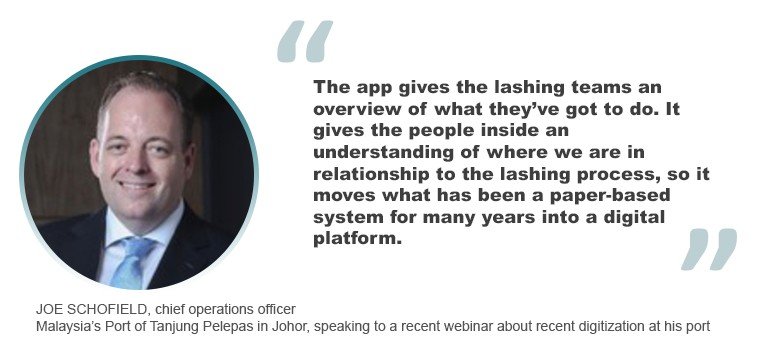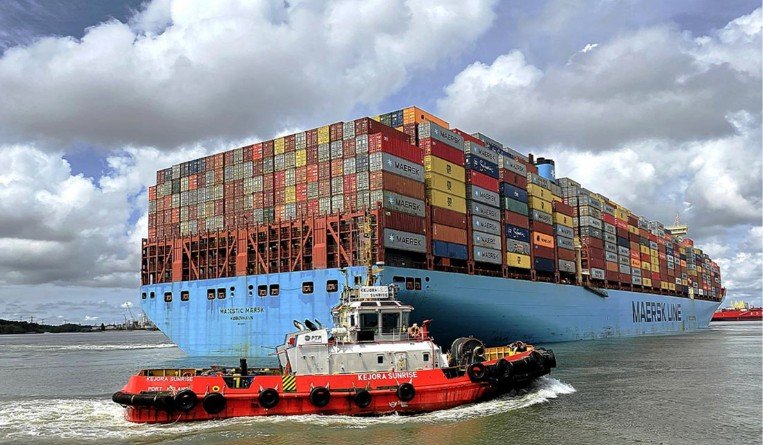Two new pieces of kit, ranging from the very large to the hand-held, look set to create commercial advantages in next generation terminal automation, participants at a Transport Events webinar have learned.
Large – and with it looking more like something out of Star Wars than the early part of the 21st century – is the Kuenz-built Freerider.
This has three new design features. The Freerider itself has increased stiffness, key for automation, and reduced gantry weight. The Kuenz Spider, with new, precise working and faster hoist systems, offers the most stable hoist and rope reeving in the market, according the company, and the Kuenz One Hand gives more accurate controls and more comfortable, ergonomic operator control for the crane operator.
Putting these together gives the Freerider the flexibility of the rubber-tyred gantry cranes with the automation and safety pluses of an automated stacking crane.
“(Kuenz decided to develop the) Freerider, which is, at the end, an automated stacking crane. Or, [you can] call it an automated RMG on rubber tyres,” Walter Schönecker, the company’s Wels, Austria-based global sales manager for ASC/Freerider, told the webinar.
On top of this flexibility, useful as that will be in busy ports, the Freerider also has advantages of speed, with Schönecker’s presentation noting gantry drive without load increased 23% and hoisting speed increased “around 50-60%.”
Significant as these savings are, the Freerider’s pitch is elsewhere. “The real big change is that we now allow customers to drive with a fully loader container all the time,” said Schönecker. It also allows for reduced positioning time, saving a few seconds – something often important in ports and to certain sorts of cargo.
(Another advantage is financial. Eight Freeriders can do the work of 10 cranes, a savings in operating expenses such as maintenance and running costs, and can reuse existing lanes and infrastructure.)
At the other end of the size scale are the apps starting to change the way the port industry works, with Malaysia’s Port of Tanjung Pelepas in Johor providing examples of just how much things are being changed.
The example given in the webinar was their lashing application. This very manual part of the loading process remained unchanged for 65 years, until Tanjung Pelepas, working with Navis, created and rolled out a new way of doing things that cuts out a lot of walking and a lot of inefficiencies by pinpointing where the work is and the details that need attending to.
On top of this, previously, the entire process was done on paper and then signed off on by the boss. Now, a detailed flow of information about how many bars need to be lashed, unlashed, and have already been lashed is distributed via one app for the crew and one for the lashing team.
“It gives the lashing teams an overview of what they’ve got to do,” Joe Schofield, PTP’s chief operations officer, told the webinar. “It gives the people inside an understanding of where we are in relationship to the lashing process, so it moves what has been a paper-based system for many years into a digital platform which makes it more efficient for the staff and easier for them and gives us a much better oversight to be efficient and effective,” he said.
Another app, also designed with Navis, accelerated the loading process, was a pinning app. This sees a clerk armed with a tablet type in the box number; the app responds by telling the clerk which vessel the box is for and what fittings are needed. Pinning is then done at a pinning station away from busy areas.
Backing this up is increased use of live analytics – something which is almost a mission for PTP. “It’s amazing how many ports still use manual documentation,” said Schofield. Live analytics by spreading information as it comes means there is no waiting till the end of a shift to get report and sometimes noticing what else could have been done but during the actually work process.
“This is important not only to identify boxes you’ve done live, but to your congestion, your waste buckets and your opportunity,” said Schofield.
Another area of change is berth planning. PTP services 200 vessels a month, so berth planning is a complicated issue, and one linked to customer relations. Improvements come from being transparent with customers by giving real-time data and via an online live platform which allows customers to log on and see where their vessel is.
He is, though, frank with those who are hesitant because of the cost and the organizational challenge it brings, and with those who don’t get the product they want first time. “If they don’t exist, go and build them,” he said.




